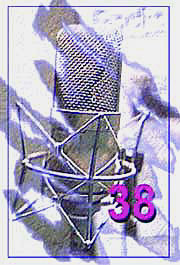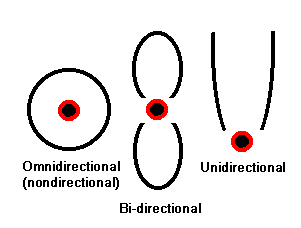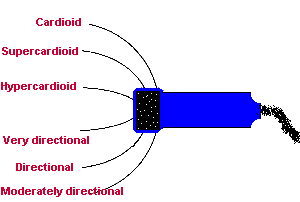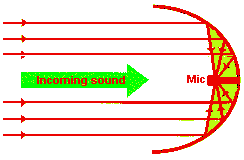|
Module 38 |
Updated: 08/04/2005 |
|
Microphones Part I
There are six common microphone designs:
These six categories include different transducer types, or approaches to converting sound waves into electrical energy. In this module we'll discuss the most popular types of mics and their characteristics, starting with - |
|
The dynamic
mic (also called a moving-coil microphone) is considered the most rugged
professional microphone. This type of mic is a good In a dynamic microphone sound waves hit a diaphragm attached to a coil of fine wire. The coil is suspended in the magnetic field of a permanent magnet. When sound waves hit the diaphragm they move the coil of wire within the magnetic field. As a result, a small electrical current is generated that corresponds to the original sound waves. This signal must be amplified thousands of times. When small size, optimum sensitivity, and the best quality are all prime considerations, another type of mic, the condenser mic, is often preferred.
Condenser mics aren't as rugged as dynamic mics, and problems can result when they are used in adverse weather conditions. Condenser mics work on the principle that governs an electric condenser or capacitor. An ultra-thin metal diaphragm is stretched tightly above a piece of flat metal or ceramic. In most condenser mics a power source maintains an electrical charge between the elements. Sound waves hitting the diaphragm cause fluctuations in an electrical charge, which then must be greatly amplified by a preamplifier (pre-amp). The pre-amp can be located within the microphone housing or in an outboard electronic pack. Although most pre-amps output an analog signal, some of the newer models convert the output to digital. Because they require a pre-amp, this means that, unlike the dynamic mics discussed earlier, most condenser mics require a source of power, either from an AC (standard Alternating Current electrical power) supply or from batteries. An AC power supply for a condenser mic is sometimes built into an audio mixer or audio board. This is referred to as a phantom power supply. When this type of power supply is used, the mic cord ends up serving two functions: it delivers the signal from the mic to the mixer and it carries power from the mixer to the pre-amp of the condenser mic. Of course, using batteries to power the pre-amp of the condenser mic is more convenient-you don't have to use a special mixer or audio board connected to an electrical power source. But, battery-powered condenser mics introduce a problem of their own: at the end of their life cycle the batteries can go out without warning. To get around any unexpected problems, especially on important productions, two miniature condenser mics are often used together. If one mic goes out, the other can immediately be switched on. This double microphone technique is called dual redundancy, a term that is somewhat redundant in itself. Summary of Dynamic and Condenser Mic Pros and Cons
Ribbon Mics Except possibly for an
announce booth (shown here), ribbon Although they can impart a deep, resonant "coloring" to sound, they are fragile and highly sensitive to moving air. This precludes their use outside the studio and on most booms-which covers most TV production applications. Ribbon mics were primary used in radio studios.
PZ
(also called PZM) stands for sound pressure In specific situations, such as when placed on a tabletop, a PZ mic will provide a pickup that's superior to that of other types of mics.
As the name suggests, contact mics pick up sound by being in direct physical contact with the sound source. These mics are generally mounted on musical instruments, such as the surface of an acoustic bass, the sounding board of a piano, or near the bridge of a violin. Contact mics have the advantage of being able to eliminate interfering external sounds and not being influenced by sound reflections from nearby objects. Their flat sides distinguish them in appearance from small personal mics.
In an earlier module we
talked about the angle of view of lenses-the area that In microphones there are three basic directional categories:
Omnidirectional Mics Omnidirectional mics (also called nondirectional mics) are (more or less) equally sensitive to sounds coming from all directions. Although this attribute would have advantages in radio where
several people could stand or be seated around a single microphone, in video production
it's almost always more desirable to use some form of directional mic. For one thing,
this will reduce or eliminate unwanted sounds (behind-the-camera noise, ambient
on-location noise, etc.) while maximizing sound coming from talent. Bi-directional Mics In a bi-directional sensitivity pattern (bipolar pattern) the mic is primarily responsive to sounds from two directions. Note drawing above. Although commonly used in radio interviews for people sitting
across from each other at a table, until the advent of stereo, bi-directional
(also called figure eight) sensitivity patterns had limited use in television.
We'll get into stereo and the need for this type of directional pattern in a later
module. Unidirectional Mics The term unidirectional simply refers to a general classification of mics that are sensitive to sounds coming primarily from one direction. There are four subdivisions in this category-each being a bit more directional:
Although these terms may sound as if they belong in a medical textbook, they simply refer to how narrow the mic's pickup pattern ("angle of view") is.
The cardioid
(pronounced car-dee-oid) pattern is named after a sensitivity pattern that vaguely
resembles a heart shape. Mics using a cardioid pattern are sensitive to sounds over a wide range in front of the mic, but relatively insensitive to sounds coming from behind the mic. Although this pattern might be useful for picking up a choir
in a studio, the width of a cardioid pattern is too great for most TV applications.
When placed two or more meters (7 or more feet) from a speaker, it tends to pick
up unwanted, surrounding sound, including reverberation from walls. Supercardioid The supercardioid is even more directional than the cardioid sensitivity pattern. Whereas the cardioid has about an 180-degree angle of acceptance, the supercardioid has about 160-degrees of coverage. When this type of mic is pointed toward a sound source, interfering (off-axis) sounds tend to be rejected. This polar pattern is similar to that of our ears as we turn our head toward a sound we want to hear and try to ignore interfering sounds.
Even more directional are the hypercardioid and lobar patterns with 140-degrees of coverage. Because off-axis sounds will be largely rejected, they have to be accurately pointed toward sound sources. Some highly directional shotgun mics (below) are included in the hypercardioid category.
So called shotgun mics with their hypercardioid or narrower angles of acceptance are one of the most widely used types of mics for on-location video work. Since they are quite directional, they provide good pickup when used at a distance of 2 to 4 meters (7-13 feet) from the talent. Like other types of directional microphones, they tend to reject sound that would interfere with the on-camera talent.
The drawing below shows another way
basic microphone sensitivity patterns (polar patterns) can be visualized. The
light blue arrows represent the direction the mics are pointed. A top view
is shown for the bi-directional mic. The magenta areas represent the areas
of maximum sensitivity.
Parabolic Mics Parabolic mics represent the most highly directional type of mic application. This category refers more to how a microphone is used than to a type of mic or its basic directional pattern. It's the The parabolic reflector can be from 30 cm to 1 meter (1 to 3 feet) in diameter. Because of the parabolic shape of the reflector, all sound along a very narrow angle of acceptance will be directed into the microphone. Parabolic microphones can pick up sound at distances of more
than 60 meters (200 or more feet). These mics are not a practical choice for general
field production work, but they are often used in sports. For parabolic mics, or any type of directional mic used on location, the person controlling the mic should always be wearing a good set of padded earphones connected to the mic's output-especially if subjects are moving. A slight error in aiming a highly directional mic can make a big difference in audio quality. |

 choice
for electronic newsgathering (ENG) work, where a wide
variety of difficult conditions are regularly encountered (such as this ENG report
on a fire).
choice
for electronic newsgathering (ENG) work, where a wide
variety of difficult conditions are regularly encountered (such as this ENG report
on a fire). Condenser
microphones (also called capacitor or electret condenser mics) are capable of topnotch
audio quality. As shown on the left, they can be made so small that they are almost
invisible. (But, the smaller they are, the more expensive they tend to be!)
Condenser
microphones (also called capacitor or electret condenser mics) are capable of topnotch
audio quality. As shown on the left, they can be made so small that they are almost
invisible. (But, the smaller they are, the more expensive they tend to be!) mics are seldom used in TV production.
mics are seldom used in TV production. microphone for standard video work, which comes under the heading of a boundary
effect microphone. This mic relies entirely on reflected sound.
microphone for standard video work, which comes under the heading of a boundary
effect microphone. This mic relies entirely on reflected sound. a
lens "sees." Microphones have a similar attribute: their directional characteristics,
or, you might say, the angle of view that they "hear."
a
lens "sees." Microphones have a similar attribute: their directional characteristics,
or, you might say, the angle of view that they "hear." The
drawing here is a highly simplified depiction of three directional patterns.
The
drawing here is a highly simplified depiction of three directional patterns.
 parabolic
reflector that creates the polar pattern for this mic, not the mic itself. In
fact, the mic used in the focus point (center) of the parabola can be any general
cardioid or supercardioid mic.
parabolic
reflector that creates the polar pattern for this mic, not the mic itself. In
fact, the mic used in the focus point (center) of the parabola can be any general
cardioid or supercardioid mic.